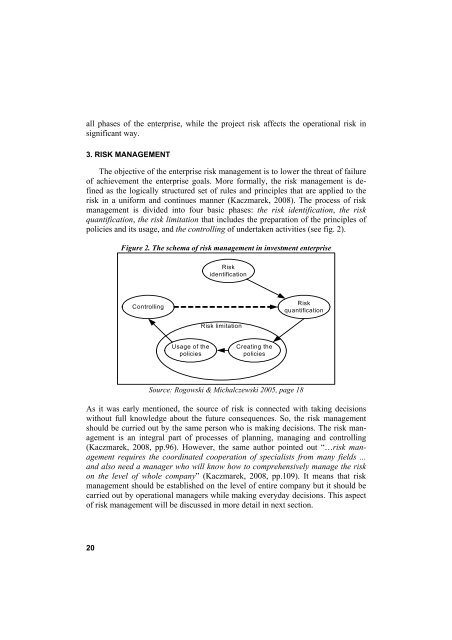INFORMATION SYSTEMS IN MANAGEMENT V - SGGW
INFORMATION SYSTEMS IN MANAGEMENT V - SGGW
INFORMATION SYSTEMS IN MANAGEMENT V - SGGW
You also want an ePaper? Increase the reach of your titles
YUMPU automatically turns print PDFs into web optimized ePapers that Google loves.
all phases of the enterprise, while the project risk affects the operational risk in<br />
significant way.<br />
3. RISK <strong>MANAGEMENT</strong><br />
The objective of the enterprise risk management is to lower the threat of failure<br />
of achievement the enterprise goals. More formally, the risk management is defined<br />
as the logically structured set of rules and principles that are applied to the<br />
risk in a uniform and continues manner (Kaczmarek, 2008). The process of risk<br />
management is divided into four basic phases: the risk identification, the risk<br />
quantification, the risk limitation that includes the preparation of the principles of<br />
policies and its usage, and the controlling of undertaken activities (see fig. 2).<br />
20<br />
Figure 2. The schema of risk management in investment enterprise<br />
Controlling<br />
Usage of the<br />
policies<br />
Risk<br />
identification<br />
Risk limitation<br />
Creating the<br />
policies<br />
Source: Rogowski & Michalczewski 2005, page 18<br />
Risk<br />
quantification<br />
As it was early mentioned, the source of risk is connected with taking decisions<br />
without full knowledge about the future consequences. So, the risk management<br />
should be curried out by the same person who is making decisions. The risk management<br />
is an integral part of processes of planning, managing and controlling<br />
(Kaczmarek, 2008, pp.96). However, the same author pointed out “…risk management<br />
requires the coordinated cooperation of specialists from many fields ...<br />
and also need a manager who will know how to comprehensively manage the risk<br />
on the level of whole company” (Kaczmarek, 2008, pp.109). It means that risk<br />
management should be established on the level of entire company but it should be<br />
carried out by operational managers while making everyday decisions. This aspect<br />
of risk management will be discussed in more detail in next section.


